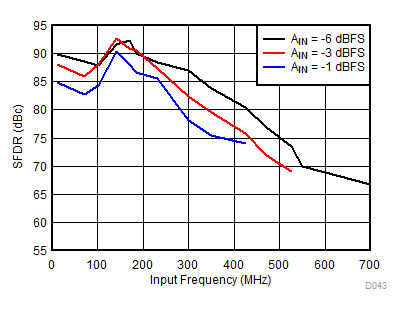JAJSH87D April 2015 – April 2019 ADS54J60
PRODUCTION DATA.
- 1 特長
- 2 アプリケーション
- 3 概要
- 4 改訂履歴
- 5 Device Comparison Table
- 6 Pin Configuration and Functions
- 7 Specifications
-
8 Detailed Description
- 8.1 Overview
- 8.2 Functional Block Diagram
- 8.3 Feature Description
- 8.4 Device Functional Modes
- 8.5
Register Maps
- 8.5.1 Example Register Writes
- 8.5.2
Register Descriptions
- 8.5.2.1 General Registers
- 8.5.2.2
Master Page (080h) Registers
- 8.5.2.2.1 Register 20h (address = 20h), Master Page (080h)
- 8.5.2.2.2 Register 21h (address = 21h), Master Page (080h)
- 8.5.2.2.3 Register 23h (address = 23h), Master Page (080h)
- 8.5.2.2.4 Register 24h (address = 24h), Master Page (080h)
- 8.5.2.2.5 Register 26h (address = 26h), Master Page (080h)
- 8.5.2.2.6 Register 4Fh (address = 4Fh), Master Page (080h)
- 8.5.2.2.7 Register 53h (address = 53h), Master Page (080h)
- 8.5.2.2.8 Register 54h (address = 54h), Master Page (080h)
- 8.5.2.2.9 Register 55h (address = 55h), Master Page (080h)
- 8.5.2.2.10 Register 59h (address = 59h), Master Page (080h)
- 8.5.2.3 ADC Page (0Fh) Register
- 8.5.2.4
Main Digital Page (6800h) Registers
- 8.5.2.4.1 Register 0h (address = 0h), Main Digital Page (6800h)
- 8.5.2.4.2 Register 41h (address = 41h), Main Digital Page (6800h)
- 8.5.2.4.3 Register 42h (address = 42h), Main Digital Page (6800h)
- 8.5.2.4.4 Register 43h (address = 43h), Main Digital Page (6800h)
- 8.5.2.4.5 Register 44h (address = 44h), Main Digital Page (6800h)
- 8.5.2.4.6 Register 4Bh (address = 4Bh), Main Digital Page (6800h)
- 8.5.2.4.7 Register 4Dh (address = 4Dh), Main Digital Page (6800h)
- 8.5.2.4.8 Register 4Eh (address = 4Eh), Main Digital Page (6800h)
- 8.5.2.4.9 Register 52h (address = 52h), Main Digital Page (6800h)
- 8.5.2.4.10 Register 72h (address = 72h), Main Digital Page (6800h)
- 8.5.2.4.11 Register ABh (address = ABh), Main Digital Page (6800h)
- 8.5.2.4.12 Register ADh (address = ADh), Main Digital Page (6800h)
- 8.5.2.4.13 Register F7h (address = F7h), Main Digital Page (6800h)
- 8.5.2.5
JESD Digital Page (6900h) Registers
- 8.5.2.5.1 Register 0h (address = 0h), JESD Digital Page (6900h)
- 8.5.2.5.2 Register 1h (address = 1h), JESD Digital Page (6900h)
- 8.5.2.5.3 Register 2h (address = 2h), JESD Digital Page (6900h)
- 8.5.2.5.4 Register 3h (address = 3h), JESD Digital Page (6900h)
- 8.5.2.5.5 Register 5h (address = 5h), JESD Digital Page (6900h)
- 8.5.2.5.6 Register 6h (address = 6h), JESD Digital Page (6900h)
- 8.5.2.5.7 Register 7h (address = 7h), JESD Digital Page (6900h)
- 8.5.2.5.8 Register 16h (address = 16h), JESD Digital Page (6900h)
- 8.5.2.5.9 Register 31h (address = 31h), JESD Digital Page (6900h)
- 8.5.2.5.10 Register 32h (address = 32h), JESD Digital Page (6900h)
- 8.5.2.6
JESD Analog Page (6A00h) Registers
- 8.5.2.6.1 Register 12h (address = 12h), JESD Analog Page (6A00h)
- 8.5.2.6.2 Registers 13h-15h (address = 13h-15h), JESD Analog Page (6A00h)
- 8.5.2.6.3 Register 16h (address = 16h), JESD Analog Page (6A00h)
- 8.5.2.6.4 Register 17h (address = 17h), JESD Analog Page (6A00h)
- 8.5.2.6.5 Register 1Ah (address = 1Ah), JESD Analog Page (6A00h)
- 8.5.2.6.6 Register 1Bh (address = 1Bh), JESD Analog Page (6A00h)
- 8.5.2.7
Offset Read Page (JESD BANK PAGE SEL = 6100h, JESD BANK PAGE SEL1 = 0000h) Registers
- 8.5.2.7.1 Register 068h (address = 068h), Offset Read Page
- 8.5.2.7.2 Register 069h (address = 069h), Offset Read Page
- 8.5.2.7.3 Registers 074h, 076h, 078h, 7Ah (address = 074h, 076h, 078h, 7Ah), Offset Read Page
- 8.5.2.7.4 Registers 075h, 077h, 079h, 7Bh (address = 075h, 077h, 079h, 7Bh), Offset Read Page
- 8.5.2.8 Offset Load Page (JESD BANK PAGE SEL= 6100h, JESD BANK PAGE SEL1 = 0500h) Registers
- 9 Application and Implementation
- 10Power Supply Recommendations
- 11Layout
- 12デバイスおよびドキュメントのサポート
- 13メカニカル、パッケージ、および注文情報
7.9 Typical Characteristics
typical values are at TA = 25°C, full temperature range is from TMIN = –40°C to TMAX = 85°C, ADC sampling rate = 1.0 GSPS, 50% clock duty cycle, AVDD3V = 3.0 V, AVDD = DVDD = 1.9 V, IOVDD = 1.15 V, and –1-dBFS differential input (unless otherwise noted)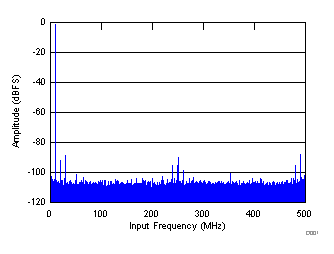
| SNR = 71 dBFS; SFDR = 86 dBc;
IL spur = 94 dBc; non HD2, HD3 spur = 89 dBc |
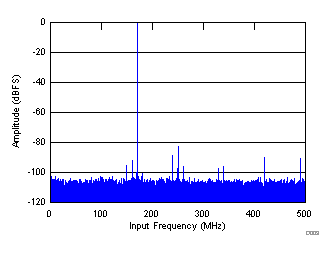 Figure 5. FFT for 170-MHz Input Signal
Figure 5. FFT for 170-MHz Input Signal 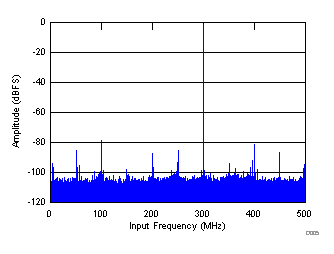
| SNR = 68 dBFS; SFDR = 77 dBc;
IL spur = 84 dBc; non HD2, HD3 spur = 85 dBc |
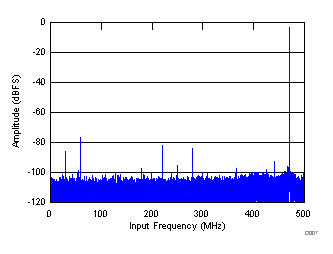 Figure 9. FFT for 470-MHz Input Signal at –3 dBFS
Figure 9. FFT for 470-MHz Input Signal at –3 dBFS 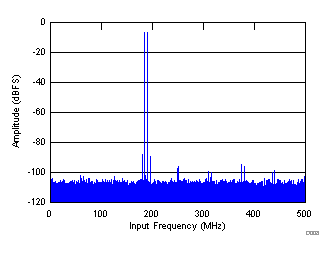
| fIN1 = 185 MHz, fIN2 = 190 MHz, each tone at –7 dBFS,
IMD3 = 88 dBFS |
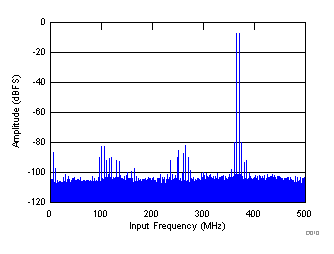
| fIN1 = 365 MHz, fIN2 = 370 MHz, each tone at –7 dBFS,
IMD3 = 80 dBFS |
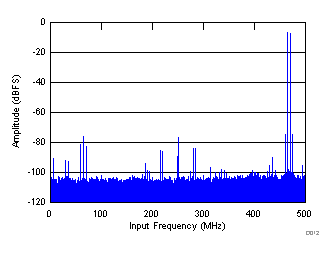
| fIN1 = 465 MHz, fIN2 = 470 MHz, each tone at –7 dBFS,
IMD3 = 75 dBFS |
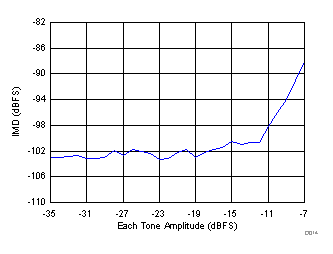
| fIN1 = 185 MHz, fIN2 = 190 MHz | ||
Input Tone Amplitude
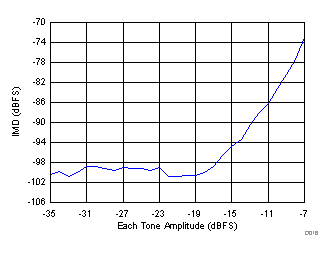
| fIN1 = 465 MHz, fIN2 = 470 MHz |
Input Tone Amplitude
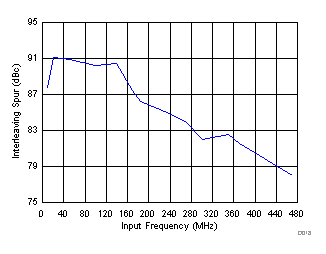
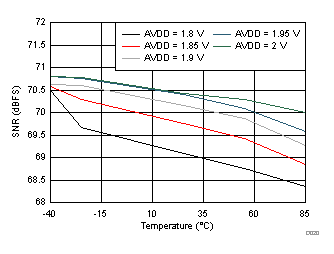
| fIN = 170 MHz |
AVDD Supply and Temperature
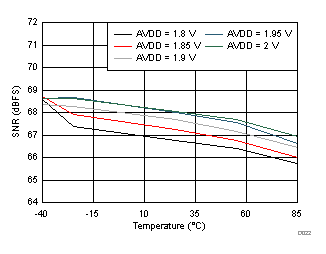
| fIN = 350 MHz |
AVDD Supply and Temperature
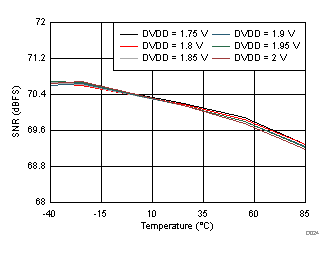
| fIN = 170 MHz |
DVDD Supply and Temperature
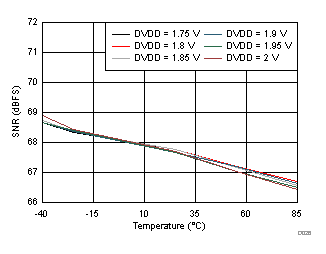
| fIN = 350 MHz |
DVDD Supply and Temperature
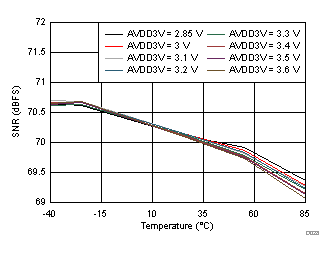
| fIN = 170 MHz |
AVDD3V Supply and Temperature
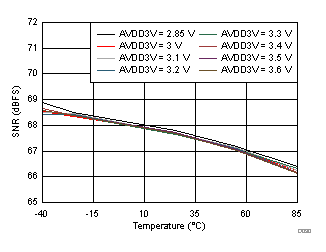
| fIN = 350 MHz |
AVDD3V Supply and Temperature
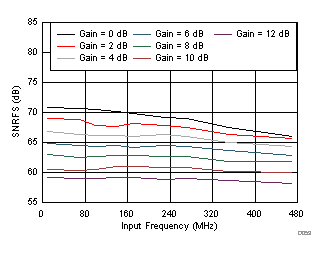
Gain and Input Frequency
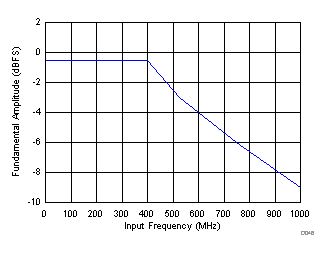
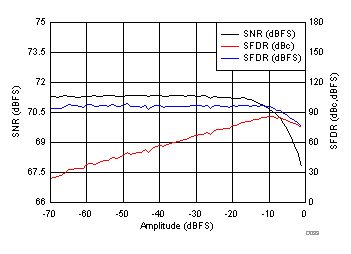
| fIN = 350 MHz |
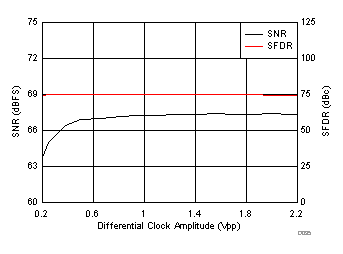
| fIN = 350 MHz |
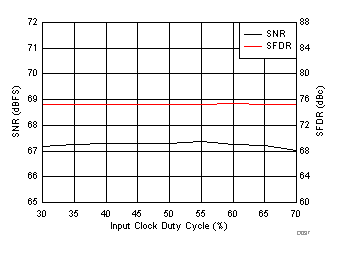
| fIN = 350 MHz |
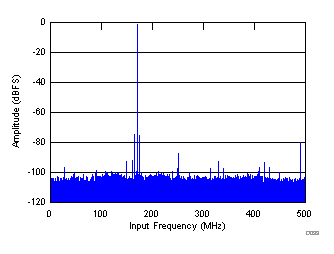
| fIN = 170 MHz , AIN = –1 dBFS, SINAD = 67 dBFS,
SFDR = 79 dBc, fPSRR = 5 MHz, APSRR = 25 mVPP, amplitude of fIN – fPSRR = –74 dBFS, amplitude of fIN + fPSRR = –76 dBFS |
Test Signals on the AVDD Supply
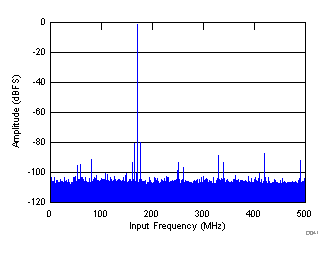
| fIN = 170 MHz , AIN = –1 dBFS, fCMRR = 5 MHz, ACMRR = 50 mVPP, SINAD = 69.1 dBFS, SFDR = 86 dBc,
amplitude of fIN ± fCMRR= –80 dBFS |
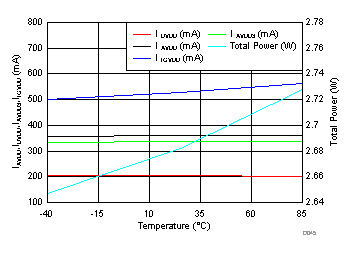
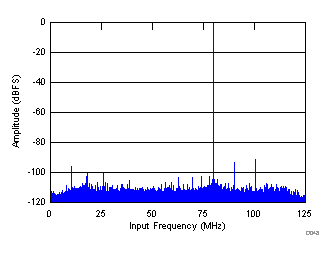
| SNR = 75.2 dBFS, SFDR = 90 dBc |
Decimate-by-4 Mode
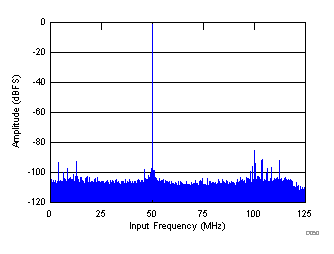
| SNR = 69.6 dBFS, SFDR = 84 dBc |
Decimate-by-4 Mode
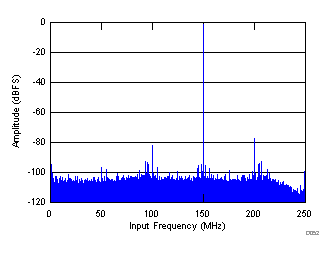
| SNR = 68.3 dBFS, SFDR = 80 dBc |
Decimate-by-2 Mode
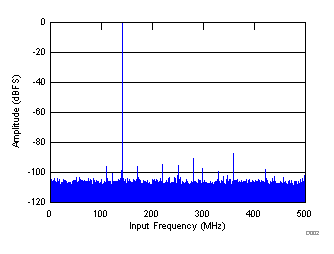
| SNR = 70.3 dBFS; SFDR = 90 dBc;
IL spur = 95 dBc; non HD2, HD3 spur = 94 dBc |
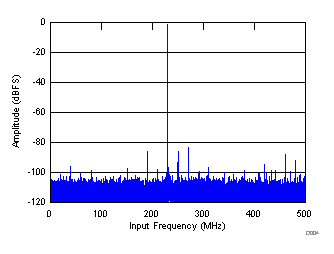
| SNR = 68.9 dBFS; SFDR = 85 dBc;
IL spur = 85 dBc; non HD2, HD3 spur = 86 dBc |
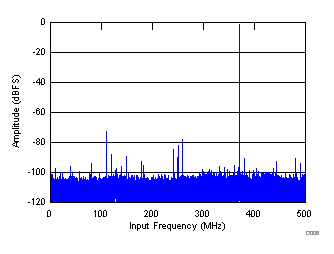
| SNR = 66.7 dBFS; SFDR = 71 dBc;
IL spur = 87 dBc; non HD2, HD3 spur = 78 dBc |
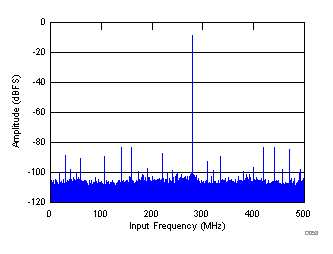
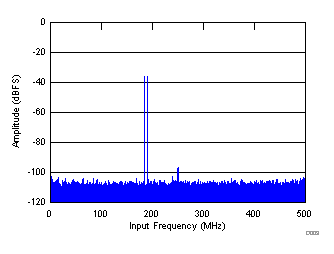
| fIN1 = 185 MHz, fIN2 = 190 MHz, each tone at –36 dBFS,
IMD3 = 106 dBFS |
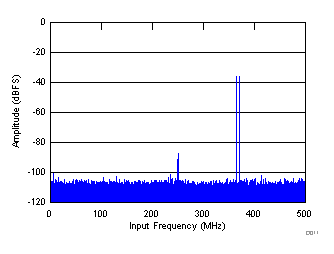
| fIN1 = 365 MHz, fIN2 = 370 MHz, each tone at –36 dBFS,
IMD3 = 105 dBFS |
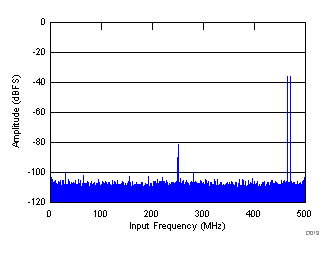
| fIN1 = 465 MHz, fIN2 = 470 MHz, each tone at –36 dBFS,
IMD3 = 106 dBFS |
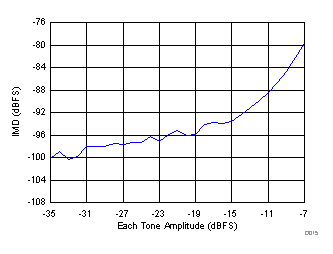
| fIN1 = 365 MHz, fIN2 = 370 MHz | ||
Input Tone Amplitude
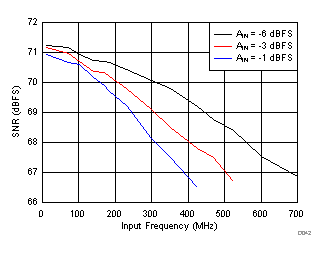
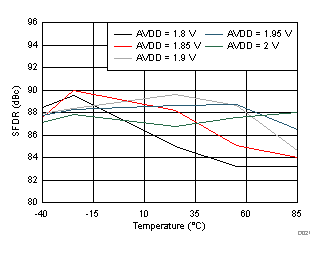
| fIN = 170 MHz |
AVDD Supply and Temperature
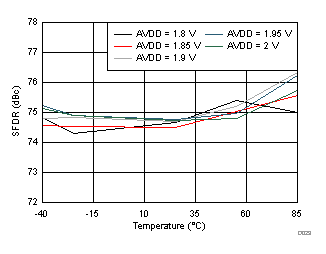
| fIN = 350 MHz |
AVDD Supply and Temperature
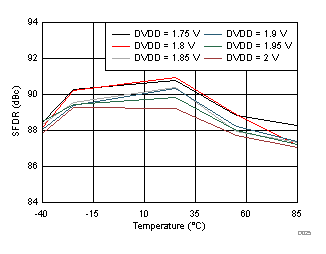
| fIN = 170 MHz |
DVDD Supply and Temperature
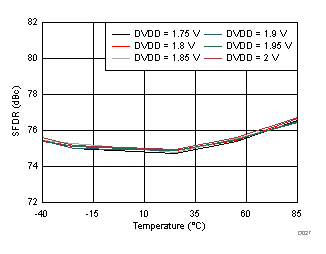
| fIN = 350 MHz |
DVDD Supply and Temperature
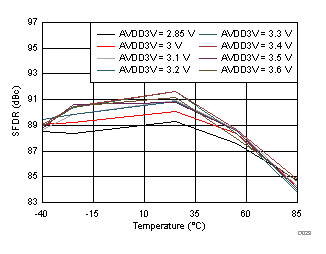
| fIN = 170 MHz |
AVDD3V Supply and Temperature
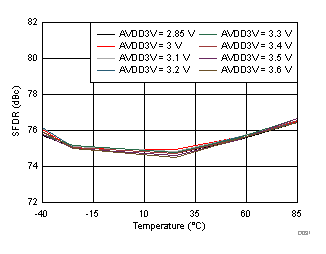
| fIN = 350 MHz |
AVDD3V Supply and Temperature
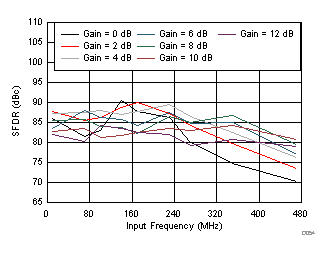
Gain and Input Frequency
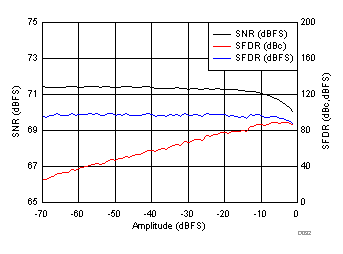
| fIN = 170 MHz |
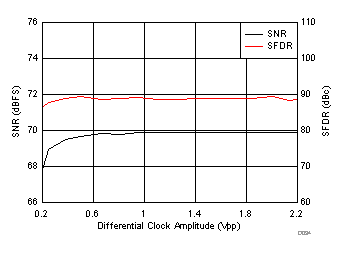
| fIN = 170 MHz |
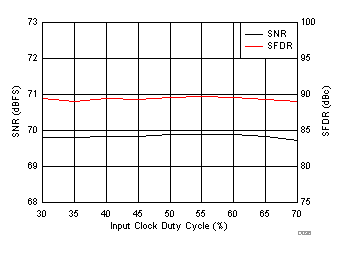
| fIN = 170 MHz |
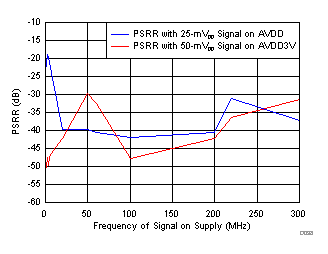
| fIN = 170 MHz |
Test Signal Frequency
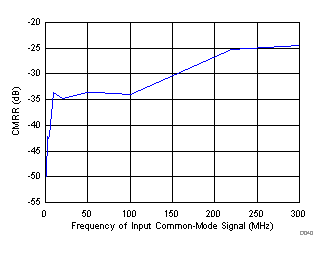
| fIN = 170 MHz | ||
Test Signal Frequency
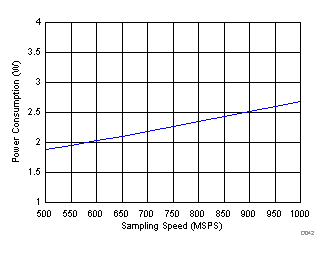
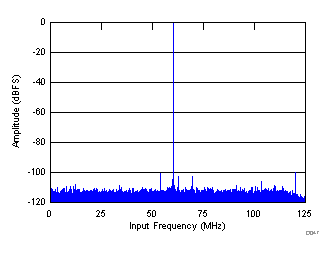
| SNR = 76.4 dBFS, SFDR = 99 dBc |
Decimate-by-4 Mode
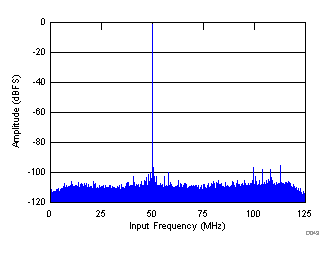
| SNR = 72.8 dBFS, SFDR = 91 dBc |
Decimate-by-4 Mode
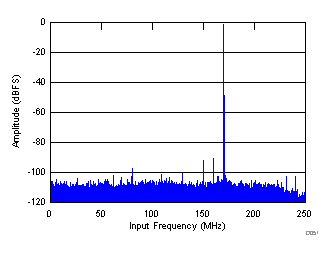
| SNR = 71.9 dBFS, SFDR = 89 dBc |
Decimate-by-2 Mode
